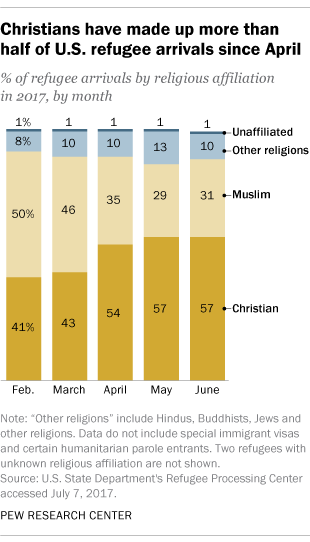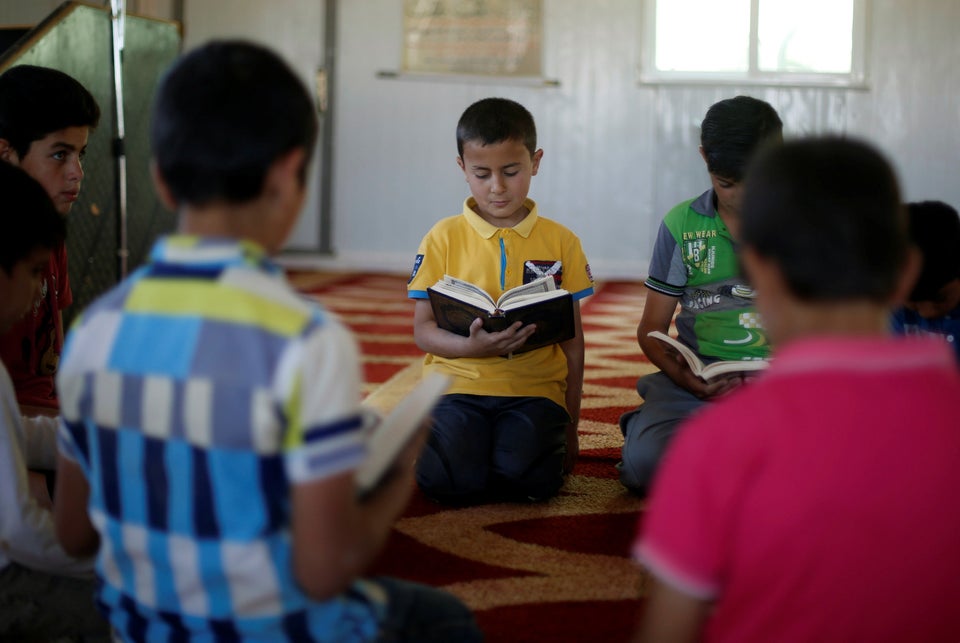Christian refugees have outnumbered Muslim refugees entering the United States during President Donald Trump’s time at the White House, according to an analysis of State Department data by the Pew Research Center.
During the period from Trump’s first full day in office on January 21 through June 30, about 9,598, or 50 percent, of all refugees arriving in the country self-identified as Christian. About 7,250, or 38 percent, were Muslim. Eleven percent of the arrivals were of other religions, including Hindus, Buddhists, Jews, and other faiths. One percent had no religious affiliation.
The figures from the past few months are a significant departure from trends in fiscal year 2016. During that year, Muslim refugees took up a slightly larger share of the number of refugees admitted to the United States. A total of 38,901 Muslim refugees came to America in fiscal 2016 (46 percent) compared to 37,521 Christian refugees (44 percent). The number of Muslims admitted in that year was the highest since 2002, when data about religious affiliation became available.

Pew researchers stated that “it’s not clear” why religious affiliation has shifted in this way. Due to the grueling 18-24-month vetting process refugees have to go through, it’s likely that many who arrived over the past few months actually applied for entry before Trump’s inauguration.
In addition, regardless of which president has lived in the White House, it’s generally been more common for Christian refugees to the U.S. to outnumber Muslims. In fact, between fiscal years 2002 and 2016, Muslim refugees have only outnumbered Christians in three years ― 2005, 2006 and 2016.
The religious composition of America’s new refugees doesn’t necessarily reflect global trends. Statistics from the UN Refugee Agency show that many of the world’s refugees continue to come from Muslim-majority countries, like Syria and Afghanistan.

In their analysis, Pew researchers found that the number of Muslims admitted to the U.S. has been declining on a monthly basis since Trump’s inauguration. In February, Muslims made up 50 percent of refugee arrivals, while Christians were 41 percent. The religious composition of the arrivals gradually shifted over the next few months. In June, Muslims made up 31 percent of arrivals and Christians were 57 percent.

Trump’s policy towards refugees has been a signature part of the reform he promised to supporters during his campaign for the presidency. President Barack Obama capped refugee admissions at 85,000 for fiscal 2016, and 84,995 people actually arrived. Trump is just a few hundred people away from closing in on his proposed 50,000-person ceiling for refugee admissions.
Trump has signaled in the past that he would prioritize resettling Christian refugees over those of other religious affiliations ― even though Muslims are also likely to be victims of terrorism and persecution worldwide.
The original version of the president’s executive order on immigration sought to ban all refugee admissions for a certain period of time, while creating an exception for religious minorities, including those from Muslim-majority countries. A revised version issued in March removed that exception for minorities, after critics from the left and right raised concerns that it would amount to a religious test.
In June, the Supreme Court agreed to review the travel ban in the fall, and allowed a watered-down version of the order to take effect in the meantime.
This means that while the president’s 50,000 cap on refugees isn’t technically in effect, the State Department has the leeway to enforce a narrow set of criteria for admissions. Refugees who can prove a “bona fide” relationship with an entity in the U.S. could still be admitted after the cap is reached.

